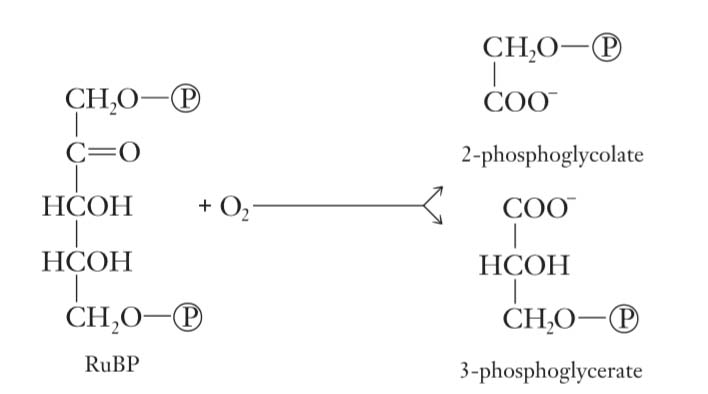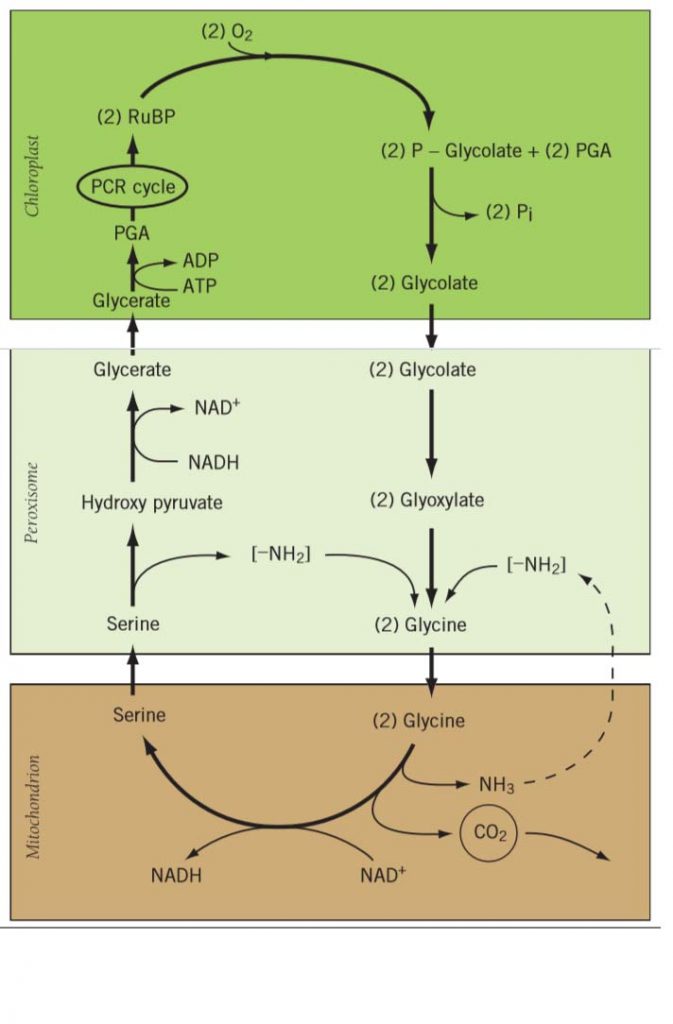Ihotorespiration (PR) is process that involves the reoxidation of products just previously assimilated in photosynthesis. The photorespiratory pathway involves the activities of at least three different cellular organelles (the chloroplast, the peroxisome, and the mitochondrion) and, because CO2 is evolved, results in a net loss of carbon from the cell.
RUBISCO CATALYZES THE FIXATION OF BOTH CO2 AND O2

Rubisco also catalyzes an oxygenase reaction, hence the name ribulose-1,5-bisphosphate carboxylase-oxygenase.
With the addition of a molecule of oxygen, RuBP is converted into one molecule of 3-PGA and one molecule of phosphoglycolate
The phosphoglycolate is subsequently metabolized in a series of reactions in the peroxisome and the mitochondrion that result in the release of a molecule of CO2 and recovery of the remaining carbon by the Calvin cycle.
The C2 glycolate cycle, also known as the photosynthetic carbon oxidation (PCO) cycle, begins with the oxidation of RuBP to 3-PGA and P-glycolate.
- The Phospho-glycolate is rapidly dephosphorylated to glycolate in the chloroplast.
- The glycolate is exported from the chloroplast and diffuses to a peroxisome.
- Taken up by the peroxisome, the glycolate is oxidized to glyoxylate and hydrogenperoxide.
- The peroxide is broken down by catalase and the glyoxylate undergoes a transamination reaction to form the amino acid glycine.
- Glycine is then transferred to a mitochondrion where two molecules of glycine (4 carbons) are converted to one molecule of serine (3carbons) plus one CO2
- Glycine is thus the immediate source of photorespired CO2.
- The serine then leaves the mitochondrion, returning to a peroxisome where the amino group is given up in a transamination reaction and the product, hydroxypyruvate, is reduced to glycerate.
- Finally, glycerate is returned to the chloroplast where it is phosphorylated to 3-PGA.
The release of carbon as CO2 during the conversion of glycine to serine is accompanied by the release of an equivalent amount of nitrogen in the form of ammonia. During active photorespiration, the rate of ammonia release may be substantially greater than the rate of nitrogen assimilation. This nitrogen is not lost, however, as the ammonia is rapidly reassimilated in the chloroplast,using the enzymes of the glutamate synthase cycle.
WHY PHOTORESPIRATION?
An increase in temperature will favor oxygenation, since as the temperature increases the solubility of gases in water declines, but O2 solubility is less affected than CO2. Thus O 2 will inhibit photosynthesis, measured by net CO2 reduction, in plants that photorespire.
